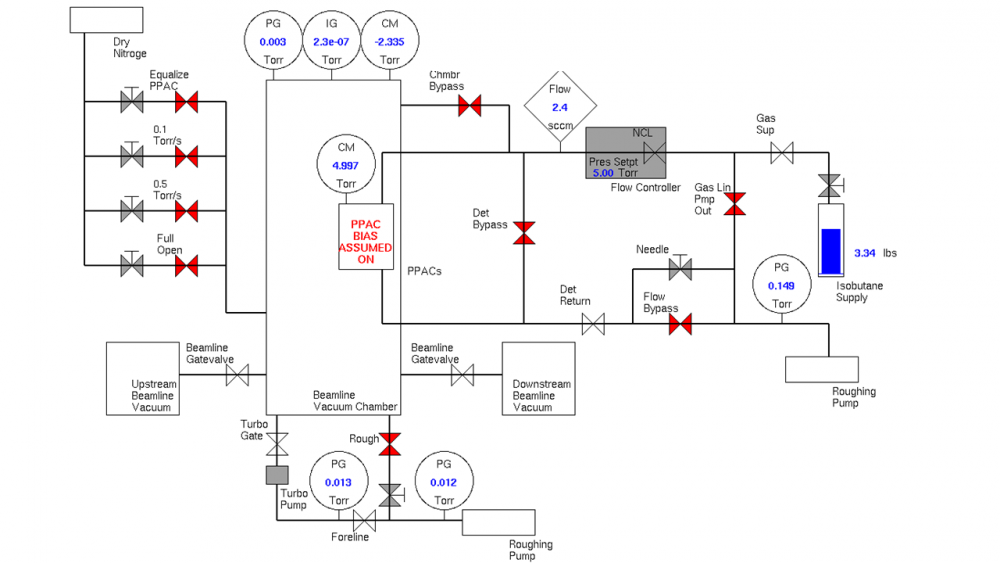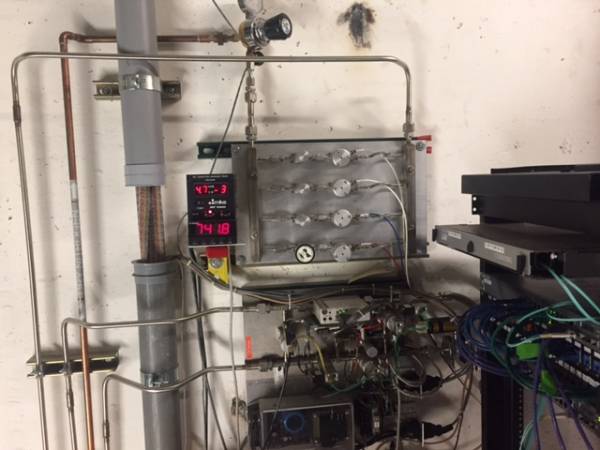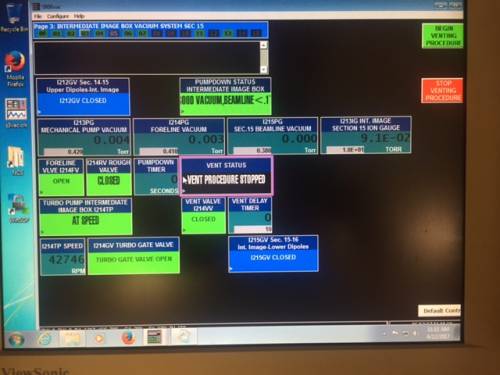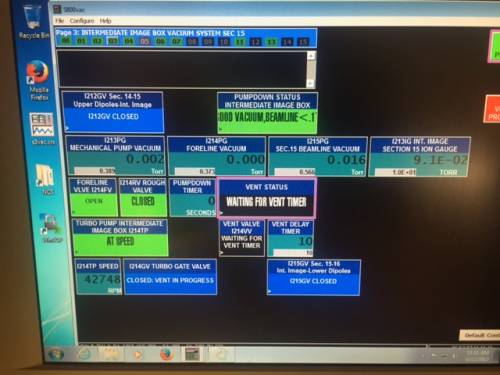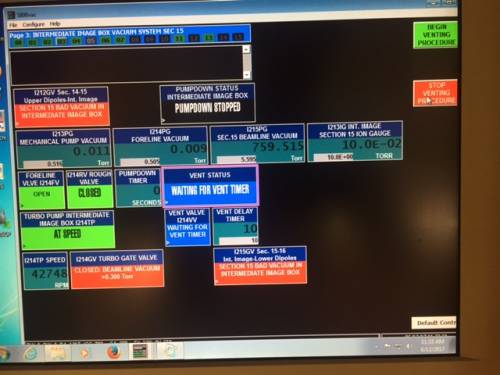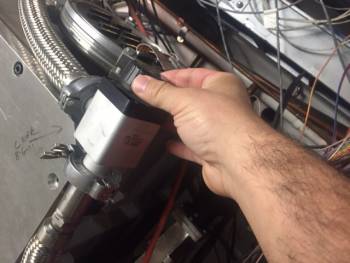This is an old revision of the document!
Table of Contents
Venting/pumping Intermediate Image box and filling PPACs with gas
General information
The procedures to vent/pump the S800 Intermediate Image box, and/or filling the PPAC detectors with gas must be done carefully to ensure that the PPACs are not damaged. For instance, before venting the chamber, we have to make sure that the PPACs are empty and equalized with respect to the vacuum in the chamber. In order to avoid errors, an automated gas handling system (II-GHS) was designed to perform these tasks safely. The system is schematically illustrated in the figure below. It shows the status of the valves (red: closed, white: open) when the intermediate image chamber is under vacuum and the PPACs are filled with gas (NOTE: This figure was taken from the A1900 GHS included in Barney. A similar GUI for the S800 II PPACs is not yet available):
The II-GHS equipment (valves, flow-meter, pipes, isobutane gas bottle. etc.) are located on the west balcony of the top level in the S3 vault (see figure below):
Vent Intermediate-image chamber
Requirements: PanelMate files S3_Gas_Handling and S800Vac
- Verify that PPACs are in automatic mode with gas removed (S3_Gas_Handling)
- The “GH System Status box should read “Auto Mode Gas Removed”
- If gas is removed but the system is not in the automatic mode, consult the Beam Physicists or Device Physicist. NOTE: the only valves that should be open in S3_Gas_Handling are the “Det Bypass” and “Chmbr Bypass
- Verify that PPACs are not biased:
- Check that the detectors are unbiased by opening the HV GUI
- Notify the system of the bias-off state by selecting the “I214BON_CONFIRM” box in S3_Gas_Handling and clicking “PP BIAS OFF CONFIRMED”
- Open S800Vac and go to page 03 (“Intermediate image box vacuum system sec 15”)
- Isolate chamber by closing gate valves I212GV and I215GV
- Turn off ion gauge I213IG
- Check box “PUMPDOWN STATUS INTERMEDIATE IMAGE BOX”. It should read “Good vacuum”
- In order to begin venting process, select box “VENT STATUS” and click “BEGIN VENTING PROCEDURE”
- Box “VENT STATUS” should change from “VENT PROCEDURE STOPPED” to “WAITING FOR VENT TIMER”.
- The status in the box “VENT STATUS” should change from “WAITING FOR VENT TIMER” to “VENT PROCEDURE STOPPED”
- You can now open the chamber
Pumping Intermediate-image chamber
Requirements: PanelMate files S3_Gas_Handling and S800Vac
- Verify that Chamber is closed and pressure-relief valve (north side of the chamber) is properly closed (NOTE: sometimes, due to overpressure from dry N2 during the venting procedure, the O-ring in pressure-relief valve flange is moved out of place)
- Verify that PPACs are not biased by opening the HV GUI
- Insert PPACs/turn on light (Diagnostic Drives PanelMate) and verify condition through sight window on south side of the chamber (be careful no to bump the bullet camera).
- Open S800Vac and go to page 03 (“Intermediate image box vacuum system sec 15”)
- Check “PUMPDOWN STATUS INTERMEDIATE IMAGE BOX”; it should read “PUMPDOWN STOPPED”. Select that box and click on “START PUMPDOWN”. The chamber will not be pumped yet because the manual roughing pump valve is closed.
- Slowly crack manual roughing valve
- Start slow (< 1 Torr/sec). Chamber pressure is displayed in I215PG in S800Vac PanelMate. There is also a local display of the mechanical pump pressure on a Granville-Phillips 275 Mini-Convectron, which is helpful to control rate of pumping.
- Verify PPACs changing shape through sighting window.
- Pump to about 100 Torr before fully opening the roughing valve.
- Once roughing valve is fully open, retract PPACs and turn lights off.
- When the pressure in I215PG is below 200 mTorr, the Turbo Pump will start automatically through the following sequence:
- I214RV will be closed
- I214FV will be opened
- I214GV will be opened
- When the pressure ready by I215PG is few mTorr, you can turn on the ion gauge I213IG. Good vacuum will take ~1-2 hours.
- NOTE: it sometimes happens that the foreline pressure rises above the trip point for the Turbo Pump (e.g. if the pumpdown timer expires before pressure is below 300 mTorr, or there is too much back-up pressure from the chamber when the foreline valve opens). In this situation, you will see that: (1) the turbo pump will stop, (2) the turbo gate valve I214GV will be closed, (3) the foreline valve I214FV will be closed and the corresponding PanelMate box will turn red and display an error message “Foreline pressure > 2 Torr”, and (4) the foreline pressure will be few Torr. In a situation like this, foreline valve needs to be bypassed open (in PanelMate) and the TP needs to be restarted:
- Select box labeled “FORELINE VLVE I214FV” and the click on “BYBASS VAC INTERLOCKS OPEN” button
- Select box labeled “TURBO PUMP INTERMEDIATE IMAGE BOX I214TP” and click “START”
- Turbo pump will start ramping speed. When the TP reaches 40000 RPM, the I214GV will open automatically.
- When foreline vacuum gets below 2 Torr, you can select “FORELINE VLVE I214FV” and click “REMOVE BYPASS”
- (Note: sometimes it is necessary to repeat this operation a couple of times).
- At the end of the procedure, close the manual roughing pump valve

